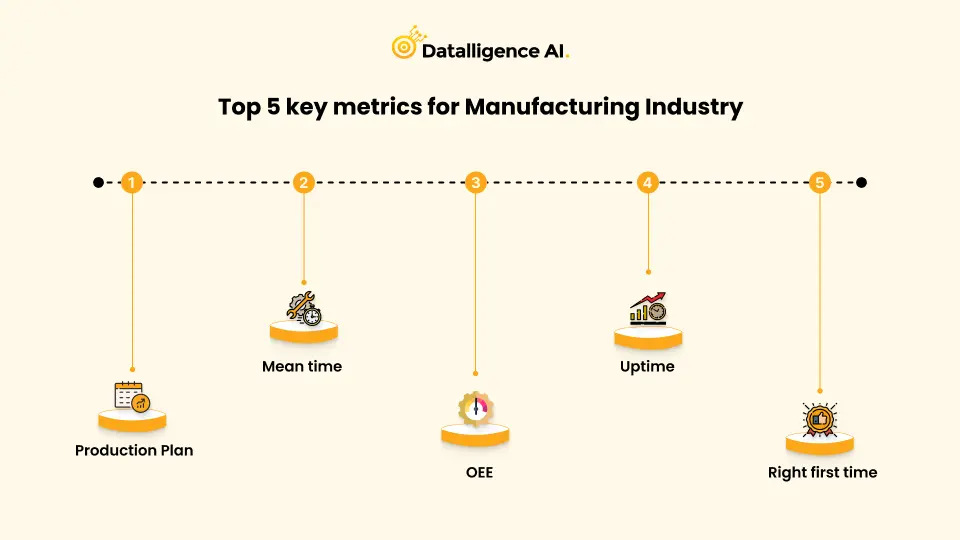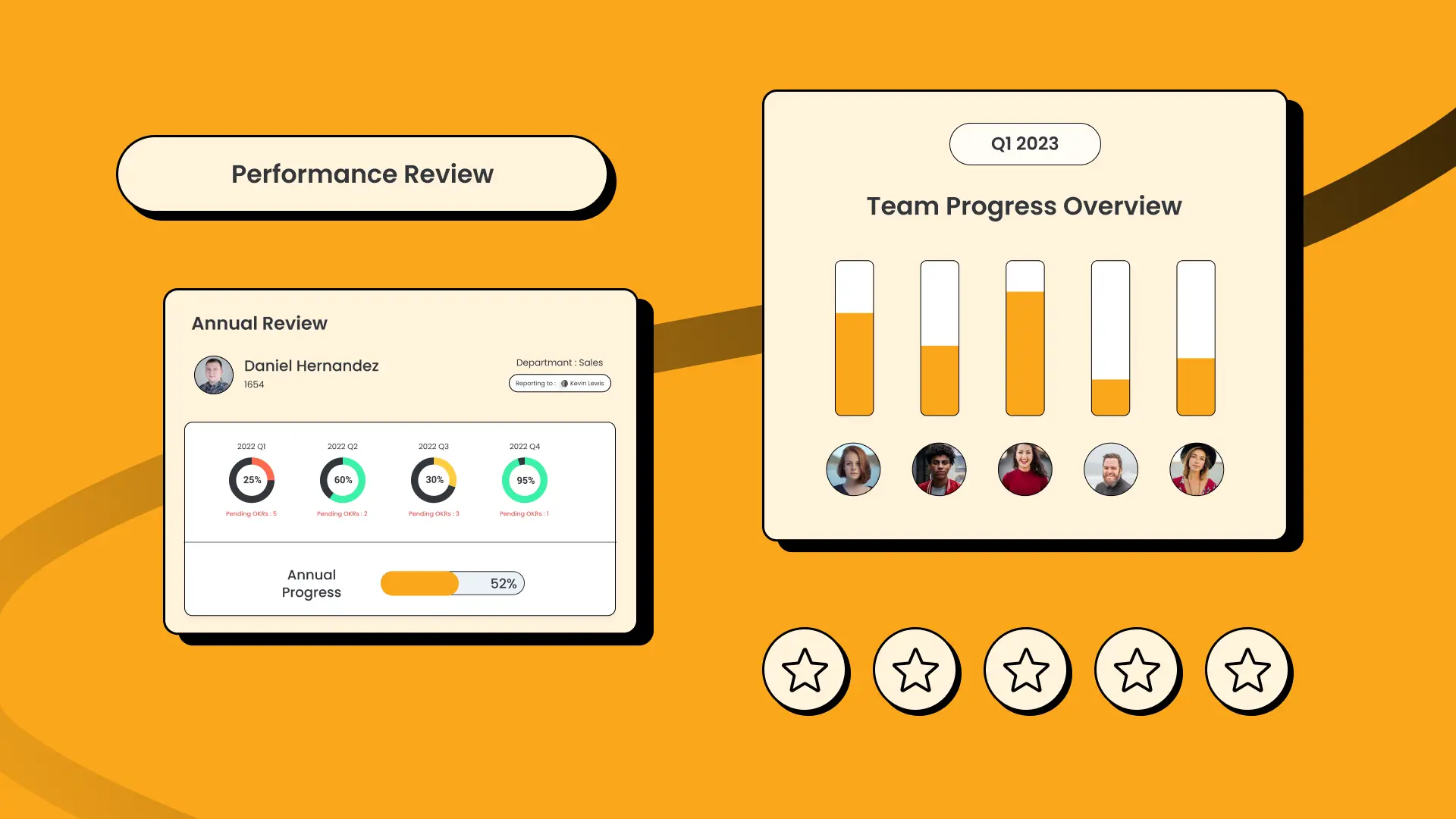Manufacturing industries are process-oriented and driven by high-quality standards. In manufacturing companies, the organization’s objectives are well defined and the key milestones (KPIs) are written to achieve individual targets, which carry different weightage and priorities. These KPIs are typically measured every month and are different for teams like supply chain, production, and quality.
In manufacturing companies, the business goals and KPIs work hand in hand. Few KPIs are required to understand the current benchmark to set the OKRs to achieve beyond what is capable today. Monthly or Quarterly planning will help to accomplish key targets.
To start with, we need to know the productivity rates and efficiency before setting the OKRs. Productivity is typically the number of units manufactured in a specific period. While measuring productivity. We can break it down into weeks and months to understand the core of it. This will help the team to forecast what is required to meet the demand or manage the delays. Since this is a highly competitive market, data is the key to review and planning.
How Does OKR Software Help the Manufacturing Industry?
It’s very important to align business priorities with the key metrics of all the departments. At a macro level, the Leadership team looks at productivity and efficiency. Objectives and Key Results (OKRs) help in aligning to the goal set by the management team. For example, Production plan Vs Actual helps in identifying productivity, and measuring OEE (Overall Equipment Effectiveness) is essential for measuring the overall plant efficiency. OKRs connect all the key metrics to deliver the organization’s priorities.

Effective Manufacturing OKRs?
Most of the manufacturing companies would have key milestones to follow for each process. Key Results are those metrics to know where you are travelling currently and with that visibility, you can create quarterly deliverables as Objectives, together called as OKRs. The OKRs collectively indicate your priorities for the next 90 days.
The OKRs for the manufacturing industry starts with an organizational goal, that gives way for measuring further departmental objective. For example, if the Profitability of a plant has to increase, the goal has to be set considering Raw materials, operational and infrastructure cost, with a clear indication of the department that will own such OKRs. Here are a few examples that can help
Top 15 OKR Examples for Manufacturing Success
1. Objective: Increase Sales in MENA by 20%
- Key Result 1: Go out and get ahold of fifteen new clients in MENA.
- Key Result 2: Raise the selling volume from existing customers by ten percent.
- Key Result 3: Lower customer churn rate by three percent.
2. Objective: Raise Production Volume by 13 Tons Before Q3
- Key Result 1: Shorten the cycle time from five minutes to one minute
- Key Result 2: Add 2 new production lines.
- Key Result 3: Reduce in-process rejections by 8%.
3. Objective: Decrease Quality Rejections by 2%
- Key Result 1: Reduce plant PPM from 108 to 80.
- Key Result 2: Lower customer rejection rate on finished goods to 5%.
- Key Result 3: Conduct 4 additional quality training sessions for staff.
4. Objective: At least 10% decrease in costs.
- Key Result 1: by better negotiation reduce raw material costs by 10%.
- Key Result 2: Logistics costs reduction by 5%.
- Key Result 3: Lower the inventory holding cost through optimizing the inventory level by 7%.
5. Objective: Implement and Drive New Strategies for Seamless Maintenance
- Key Result 1: Increase MTBF by 1 hour with condition-monitoring sensors.
- Key Result 2: Decrease MTTR by 25 minutes.
- Key Result 3: Implement a preventive maintenance schedule for 100% of equipment.
6. Objective: Launch an SUV by Q4 that is Safer and More Sophisticated
- Key Result 1: Ensure the front chassis endures a 10,000-cycle stress test.
- Key Result 2: Optimize passenger airbag pressure by 10%.
- Key Result 3: Complete all regulatory safety certifications by Q3.
7. Objective: Increase Capacity Utilization
- Key Result 1: Boost utilization from 80% to 90%.
- Key Result 2: Decrease throughput time by 3 minutes.
- Key Result 3: Implement lean manufacturing principles in 5 key areas.
8. Objective: Comply with and Enhance Audit Practices and Procedures
- Key Result 1: Complete internal audit by May.
- Key Result 2: Achieve zero non-conformities in customer audits.
- Key Result 3: Implement 3 new compliance procedures.
9. Objective: Create a Learning Culture Within Teams
- Key Result 1: Increase training hours by 8 hours per employee.
- Key Result 2: Launch a training application by May.
- Key Result 3: Conduct quarterly knowledge-sharing sessions.
10. Objective: Foster a Safe Work Culture
- Key Result 1: Ensure zero accidents in the plant.
- Key Result 2: Raise safety awareness to 100%.
- Key Result 3: Conduct monthly safety drills.
11. Objective: Enhance Customer Satisfaction
- Key Result 1: Raise the net promoter score (NPS) by fifteen points.
- Key Result 2: Reduce customer complaints by twenty percent.
- Key Result 3: Implement a customer feedback system by Q2.
12. Objective: Increase Supply Chain Efficiency
- Key Result 1: Shorten supply chain lead time by ten percent.
- Key Result 2: Attain a ninety-five percent on-time delivery rate.
- Key Result 3: Decrease supply chain costs to seven percent.
13. Objective: Reduce Environmental Impact
- Key Result 1: Cut energy consumption by 15%.
- Key Result 2: Reduce waste generation by ten percent.
- Key Result 3: I100% recycling program for waste materials is in place.
14. Objective: Optimize inventory management
- Key Result 1: Lower inventory holding costs by twelve percent.
- Key Result 2: Enhance inventory turnover ratio by twenty percent.
- Key Result 3: Adopt just-in-time inventory systems.
15. Objective: Enhance Workforce Productivity
- Key Result 1: Increase labor efficiency by 10%.
- Key Result 2: Implement a new productivity tracking system by Q2.
Key Result 3: Introduce performance incentives to boost productivity by 5%.
Implement OKR Software solution for your Manufacturing Industry.
While implementing OKRs in the manufacturing industry it is essential to understand the process and key metrics that support achieving the organization’s performance. Setting clear department goals and individual goals is very important as there are various metrics available. Recognizing the key metrics that matter to business will help in crafting OKRs.
Talk to our experts more about OKR Software.
Talk to our experts to more about manufacturing OKRs. Our domain experts can work along with the organizations to create solutions that are specific to organizations. OKRs are industry agnostic and it is very interesting when it is applied to process and metric-driven manufacturing verticals. The outcome is quantified and hence the results are more tangible in nature. Write to Datalligence for implementing OKRs today.











